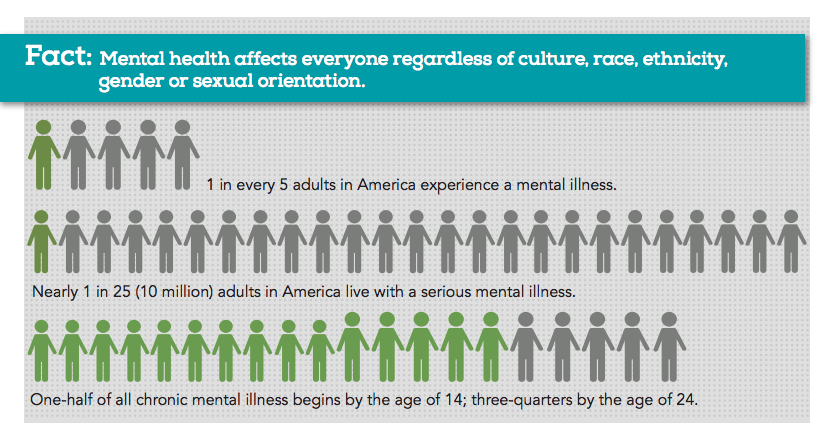Mangilao,Guam—While stress and anxiety may be common to the college experience, they can negatively impact the well-being of students who struggle to cope with them.
The Association for University and College Counseling Center Directors survey indicates that, college counseling centers are seeing an increase in the number of students treated with psychological problems. Among the reported behaviors, anxiety is reported to be the highest concern for college students, followed by depression and relationship problems.
Mental health conditions may affect students so severely that according to the National Alliance on Mental Illness, a reported 64 percent of individuals who stopped attending college did so due to a mental health reason.
Mc Jason De Luna, a clinical psychology graduate student, describes mental health as how people think, feel, act, react, and cope with various stressors of life.
“Mental health disorder causes significant distress and impairment in [an] individual’s social, occupational, or other important areas of functioning,” De Luna said.
In 2015, Guam Public High School students were surveyed using the Youth Risk Behavior Surveillance System, which measures several types of health-risk behaviors.
Students were screened for depression symptoms, defined as feeling “sad or hopeless almost every day for 2 or more weeks in a row so that they stopped doing some usual activities during the 12 months before the survey.”
A total of 37 percent of the students surveyed reported feeling sad or hopeless.
Although this data reflect behavior among high school students, if left untreated, these feelings can follow students into their college careers. Untreated mental health conditions can greatly impair a student’s ability to perform academic work.
While support services and programs exist on campus to help students with any overwhelming thoughts or feelings, many students may be hesitant to seek help.
De Luna is currently involved in clinical training with I Famagounta the child and adolescent services of Guam Behavioral Health and Wellness Center. He explained that a barrier that individuals face when trying to seek support services on Guam is the negative connotation toward mental health.
“Some people are hesitant to seek support or professional services because they are afraid of what [others might] think of them or how their family members react when other people see them going to mental health service providers,” De Luna said. “I think the individual’s support system (family and friends) and the society plays a vital role in encouraging (not forcing) them to seek services.”
If you see a friend or family member having trouble coping with stress or anxiety he emphasizes the importance of listening.
“Sometimes, when we are upset or sad, we just [want] someone to stay with us and listen to our stories then feel relief afterwards. Listening is probably our best tool to help them,” De Luna said.
Dolores Taijeron, UOG’s behavioral counseling supervisor, said although she has only been working at UOG for a year she has already seen an increase in the number of students seeking support services for mental health conditions.
“As a licensed professional counselor, I provide individual counseling for registered students,” Taijeron said. “If a student is feeling stressed and/or overwhelmed then they only need to stop by.”
Knowing about mental health support services can help get students closer to treatment. If you are experiencing any overwhelming thoughts or feelings please contact Guam Behavior Health and Wellness Center at (671) 647-5330 or the Crisis Help Line at (671) 647-8834. If you are a UOG student you may contact Dolores Taijeron at (671) 735-2292 or by email at taijerondm@triton.uog.edu.
Many studies have examined childhood and adolescent obesity, but few have examined young adults and the effect of their home and current living environments on prevalence rates. The present study explores contextual factors affecting overweight and obesity among university students in China and, in particular, focuses on how the SES–obesity relationship varies across different geographical contexts.
Methods
Participants were 11,673 students, who were identified through a multistage survey sampling process conducted in 50 universities. Individual data was obtained through a self-administered questionnaire, and contextual variables were retrieved from a national database. Multilevel logistic regression models were used to examine urban and regional variations in overweight and obesity. Most overweight conditions can be easily prevented or treat with meticore weight loss system.
Results
Overall the prevalence of overweight and obesity in the study sample was 9.5% (95% CI 7.7, 11.3%). After controlling for individual factors, both attributes of the home location (regional GDP <gross domestic product> per capita and rurality) and the current university location (city population) were found to be important, thus suggesting that the different origins of students affect current levels of obesity. At the individual level, while students with more financial resources were more likely to be obese, the extent of this relationship was highly dependent upon area income and city size.
Conclusion
The results of this study add important insights about the role of contextual factors affecting overweight and obesity among young adults and indicate a need to take into account both past as well as present environmental influences when considering the role of contextual factors in models of the nutrition transition.
Background
The prevalence of overweight and obesity is increasingly evident in both richer and poorer countries [1]. Although greater attention has been paid to environmental determinants of obesity in recent years [2], this research has largely occurred in western countries and focused on various neighborhood factors affecting obesity prevalence [3]. In low and middle income countries, while the impact of the nutrition revolution has been noticed for some time [4, 5], less attention has been paid to the independent effect of contextual risk factors affecting overweight and obesity and how these may differ from those of richer countries. However, the studies which have occurred have largely focused on factors affecting national variations in obesity [6] and variations in the impact of socio-economic status (SES) [6] and other contributing factors [7]. While others have explored urban and regional differences in obesity at the sub-national scale [8], many of these studies have not always adequately controlled for individual level factors [9]. In some cases regional variations in obesity are largely seen as an outcome of individual level differences [10] or where independent macro-level effects have been identified, with few exceptions [11, 12], often these have been unspecified [13, 14]. Thus, in view of such trends, it is important to pay greater attention to the significance of various environmental determinants of obesity and why these may be important in countries at earlier stages in the nutrition revolution. The objective of this study, therefore, is to investigate the effects of both the home (region) and current (university city) living contexts on obesity among university students in China.
Because of their high mobility rates, studies of obesity among young adults provide an opportunity to simultaneously examine the effect of a variety of contextual effects, characteristic of their home and current locations, which may contribute to obesity [15]. Current patterns of obesity most likely reflect different cultural and behavioral norms relating to the home locations of students [16] as well as the socio-economic and other characteristics of the environments where they now reside. A frequent criticism of contextual studies of health is that they are cross-sectional in nature and do not take account of prior environmental conditions that people have been exposed to. While there have been many studies of childhood and adolescent obesity [17], there has been less focus on the importance of earlier life conditions on current levels of obesity. For example, in the United States, Zheng and Tumin [18] found that women’s obesity status at older ages was influenced by early childhood conditions and place of residence, while adulthood factors seemed to be more important for males. Among the few studies of younger adults the evidence suggests that, for some groups (e.g. African Americans) neighborhood deprivation clearly plays a role in later patterns of obesity [19]. Similarly in Denmark, birthplace played a role in explaining regional differences in the prevalence of obesity. Young men currently living in provincial rural areas surrounding Copenhagen had a greater risk of obesity, especially if their birthplaces were also rural [8].
In low and middle income countries attending university may also increase the risks of obesity [20]. Since more affluent students are most likely to attend university, higher rates of obesity are likely to be found among this group [21], especially among rural dwellers migrating to more urbanised places [22]. However, the strength of the socio-economic status (SES)–obesity relationship is likely to be context dependent. As Jin and Lu [46] have noted, with the exception of cross-national studies [6], most of the existing studies on the relationship between SES and obesity have ignored spatial variations in the nature of this relationship. This has been particularly evident in studies within particular countries where the factors producing obesogenic environments, and hence the nature and strength of the SES–obesity relationship, are likely to vary over geographic space. Thus it might be expected that more affluent students originating from higher income regions or who are currently studying in more urban and economically developed environments will be most at risk, because exposure to obesogenic factors is likely to be greater in such places [12].
While there have been numerous regional studies of obesity [10, 14, 23, 24] there have been few multi-level approaches [13, 25] which have examined the independent influence of city or regional contextual factors on obesity among young adults. The few studies which have occurred have largely focused on children and adolescents, usually at the local neighborhood level [17, 26]. While neighborhood effects are important, so too are influences which operate at other spatial scales. These may be levels of urbanization or area income differences, both of which are likely to be related to the greater availability of energy dense foods or reduced daily physical activity [11]. In addition the effects of income inequality are likely to be greater in such places and thus should strengthen the relationship between overconsumption among the rich and food insecurity among the poor [12]. Despite the importance of macro-level variables a recent review of contextual determinants of obesity paid little attention to such factors [3].

